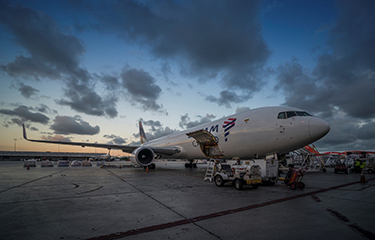Santiago, Chile-based LATAM Airlines, the largest Latin American carrier, will continue to convert more of its planes into freighters, seeking to bolster its status as the top transporter of Chilean salmon.
When the COVID-19 crisis first hit Chile, salmon producers faced problems in shipping product as international borders began closing. In turn, LATAM was forced to drastically reduce operations due to plunging passenger numbers, and in May 2020, it filed for Chapter 11 bankruptcy protection.
The process did not disrupt its cargo business, and in fact, like many other airlines, it decided to redouble its focus on cargo transport. Earlier this year, LATAM announced it would convert eight Boeing 767-300ERs into freighters, to be implemented in two stages. The move – which is expected to boost the cargo operator’s joint capacity by up to 80 percent – will see four converted aircraft in the first phase, between 2021 and 2022. Four more airplanes will be converted in the second phase, for delivery between 2022 and 2023.
By adapting the eight Boeing 767-300ER aircraft into Boeing Converted Freighters (BCF) in the next three years, LATAM will operate a total of 19 of the 767-300ER freighters. Highlighting the synergies to be realized in operating a single type of aircraft, the company said the move would increase service options and solidify the LATAM Group as the leading group of cargo operators in South America, reinforcing its operations from North America and Europe into South America, while also expanding operations in the flower markets of Ecuador and Colombia.
According to data available from Chile’s Civil Aeronautics Board, the LATAM group – including LATAM Chile, LATAM Cargo, LATAM Airlines, LATAM Argentina, LATAM Brasil, LATAM Ecuador, LATAM Paraguay, LATAM Peru, LATAM Cargo Brasil, and LATAM Cargo Colombia – moved 122 million metric tons (MT), or 50.5 percent, of the total 242 million MT in cargo export handled by airlines operating in Chile during the full year 2020. The runner up was Atlas Air, which moved 40.3 million MT.
“The salmon industry in Chile has been and will continue to be relevant to LATAM Cargo. For this reason, from the beginning of the pandemic we took decisions in order to safeguard our offer,” LATAM Cargo Group Commercial Vice President for South America Claudio Torres told SeafoodSource. “Specifically, we increased the frequencies from South America to North America and, for the first time in our history, we began to use passenger aircraft for the exclusive transport of cargo, which mitigates the restriction of belly capacity. As a result of these decisions, we generated more capacity than we had prior to the pandemic.”
Torres did not offer specific breakdowns regarding LATAM’s weighting of salmon with respect to total cargo handled from Chile.
LATAM Cargo CEO Andrés Bianchi said the move also allows the airline’s affiliates to expand their networks in domestic markets, where e-commerce is driving higher air cargo traffic. Additionally, LATAM has left the Argentine market and refocused on expanding services in Colombia, according to Simple Flying.
LATAM reported a 2020 net loss of USD 4.55 billion (EUR 3.8 billion) and an operating loss of USD 1.67 billion (EUR 1.39 billion). Its revenue fell 58.4 percent to USD 4.33 billion (EUR 3.62 billion), based on a 62 percent plunge in passenger volume and a 13 percent drop in cargo tonnage, according to Air Cargo News.
“When the pandemic started, LATAM entered this crisis as a healthy and profitable group of airlines, but we are subject to exceptional circumstances that have led to a collapse in global demand for our services,” Alvo said last year. “Despite the deep crisis the industry is enduring due to the pandemic, we maintain our commitment to support the region’s exporters and importers by providing them with more and better options to carry their cargo to their destinations. As a result, growth plans have been accelerated with the conversion of up to eight Boeing 767-300ERs in the next 30 months. This investment, together with the significant cost efficiencies that we have generated during the Chapter 11 process, puts us closer to achieving our aspiration of being the best alternative for cargo customers.”
Photo courtesy of LATAM Airlines







